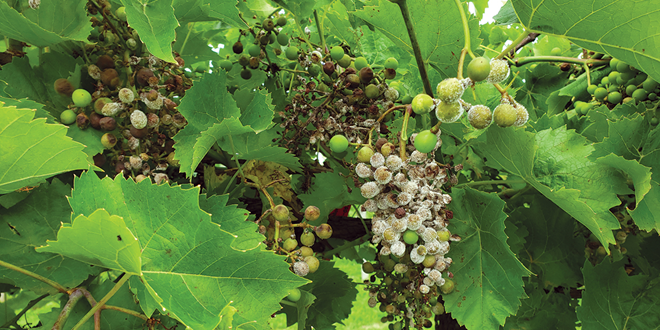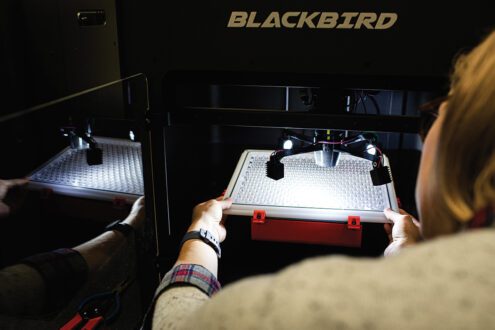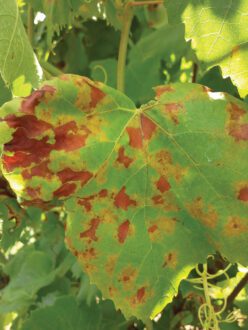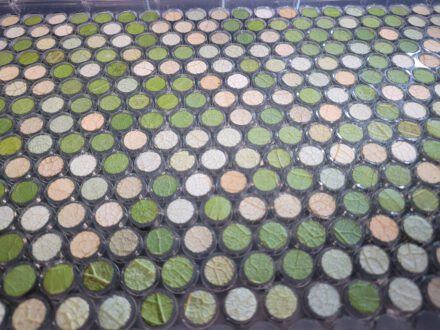

Mar 3, 2024Powerful grapevine gene fights downy mildew
Downy mildew has been a concern for grape growers for generations, particularly in the Eastern U.S., where moisture allows the fungal disease to defoliate vineyards if untreated.
“It can cause nearly 100% yield loss if growers don’t do a good job of managing it,” said Lance Cadle-Davidson, a research plant pathologist with the USDA-Agricultural Research Service’s Grape Genetics Research Unit at Cornell University’s Geneva, New York, campus. “And the main way they manage it is with chemical pesticides, fungicides.”


Cadle-Davidson is also a Cornell adjunct professor in the College of Agriculture and Life Sciences and part of a team that’s studying a grape downy mildew resistant gene. It’s not the first such gene discovered and used as a tool in breeding programs — about 40 of the genes have been discovered, but this is one of the strongest in resisting the disease.
The variety containing the resistance gene, Vitis x doaniana, is a naturally occurring hybrid of two other species. Cadle-Davidson and the Cornell team published research on the discovery in September in the journal Plant Physiology. It’s been a long process since he first observed the downy mildew resistance in the wild Vitis x doaniana grapevine more than 15 years ago at the USDA’s Plant Genetics Resources Unit, home to about 1,400 unique grape vines, as well as thousands of apple and tart cherry trees. It’s one of two such national repositories for grape varieties.


Finding and exploiting plant genes that are resistant to disease is key as fungi develop their own resistance against fungicides.
“One of the big challenges is we’re losing tools from our toolbox, you know, as the fungi evolve to overcome our commonly used fungicides,” Cadle-Davidson said. “And so it’s really critical that we implement host resistance for future generations. How else are we going to control disease in the future?”
Developing varieties that can protect themselves isn’t a cure-all, however, he said, because fungi will continue to evolve to overcome a plant’s natural resistance.
“We’re trying to understand and predict how a pathogen is going to evolve against our current production practices, and beat it to the punch,” Cadle-Davidson said. “And preferably do so with more environmentally friendly approaches that require fewer tractor passes, fewer fossil fuels and fewer chemical inputs.”


Cadle-Davidson’s career has been focused on identifying beneficial genes, developing DNA markers and providing breeders with the material needed to grow and market grapevines that are resistant to regional diseases. Several years ago, the Virginia grape industry approached him to develop a downy mildew resistant program. The program launched in 2023.
Cheng Zou, research associate at Cornell University’s Bioinformatics Facility, Qi Sun, co-director of the facility, and Surya Sapkota, former postdoctoral researcher and now grape breeder at the USDA, worked on the paper with Cadle-Davidson.
VitisGen research into powdery mildew
In 2011, the USDA-funded VitisGen was established as a breeding and genetics program focused on powdery mildew, which favors dry conditions and can be found in vineyards throughout the country.


“It doesn’t matter what the weather’s like. It’s a problem,” Cadle-Davidson said. “It’s a nuisance everywhere grapes are grown.”
The VitisGen project has provided the grape industry with tools for genetics and breeding, he said, through a collaboration of 65 faculty researchers from 15 institutions.
“We all agree powdery mildew (research) is important across the U.S., everywhere people are breeding, whether they’re breeding for table grapes and raisin grapes in the Central Valley (of California) or for winegrapes in Minnesota, Missouri or New York,” he said. “One of the offshoots, though, is we’ve developed so many really useful technologies for breeders in doing this, that traits that are more regional interests have also benefited.
“And this downy mildew (research) is one that has benefited from all the foundational work that we’ve had in powdery mildew resistance breeding,” Cadle-Davidson said.
— Chris Koger, managing editor
Top photo: Cornell University researchers have found a grapevine gene that is resistant to grape downy mildew. Photo courtesy of USDA.














